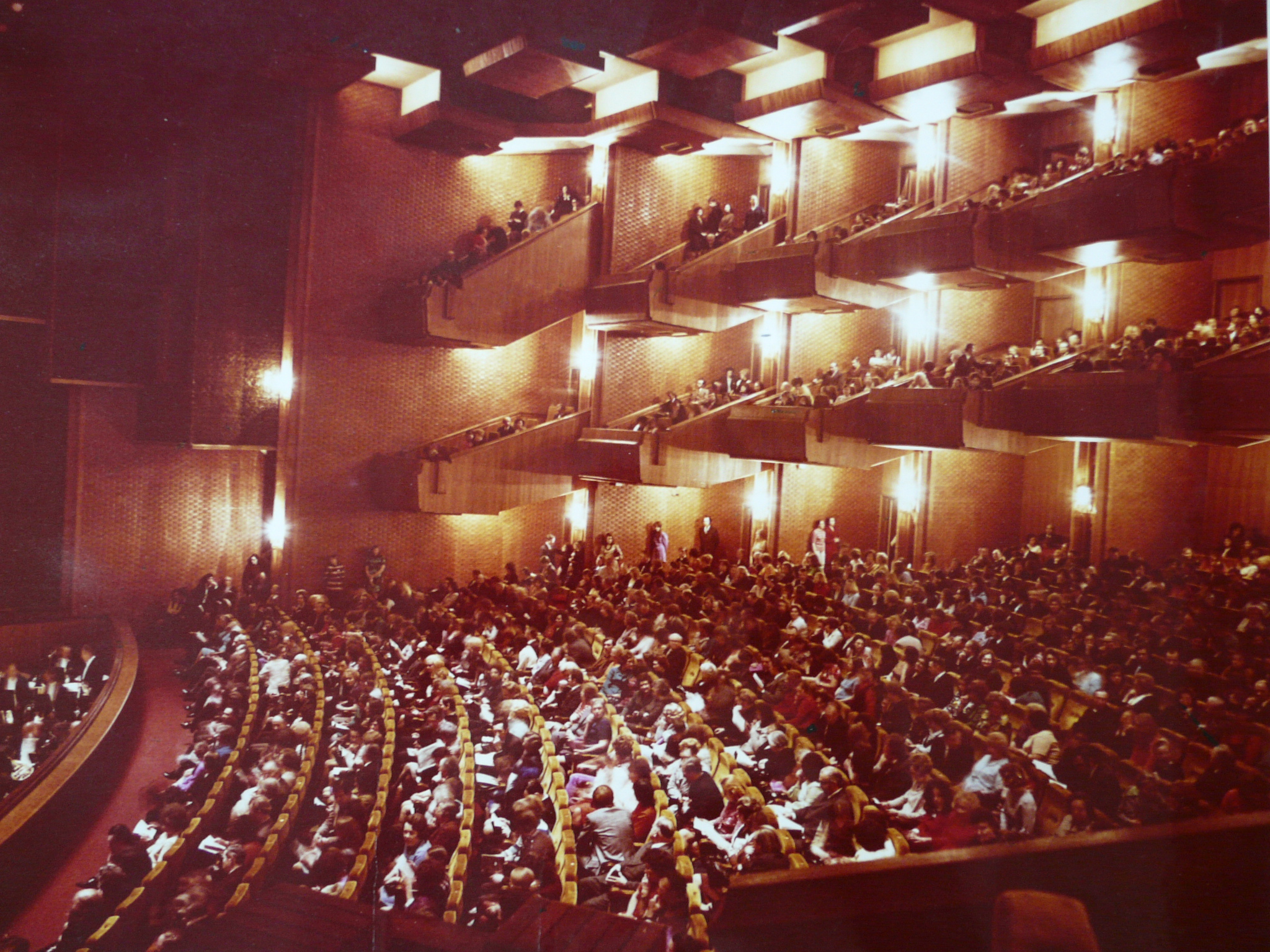The clearest examples of the new architectural trends were found in public projects that benefitted from the special attention and financial support of the central government. The 1970s saw the proliferation of new buildings to house government institutions. In Vilnius, this wave of construction included such important sites as a central complex of administrative buildings consisting of the Lithuanian SSR Supreme Soviet Presidium Building (known today as the Lithuanian Seimas [Parliament], designed by Algimantas and Vytautas Nasvytis, 1978–1982), the Republican Council of Labor Unions (Česlovas Mazūras, 1979), and the Ministry of Finance (Andrius Gudaitis, 1978); the Ministry of Communications and the Central Telephone Exchange complex (Justinas Šeibokas, 1979); the Agricultural Economics Research Institute and Computing Center (Čekanauskas, 1970–1979); the headquarters of the Lithuanian Communist Party's Central Committee (today home to the Lithuanian Government and Prime Minister's offices, designed by Čekanauskas, 1976–1982); and the Political Education Hall in Kaunas (today the main building of Vytautas Magnus University, architect: Boleslovas Zabulionis, 1974).
All of these structures shared several traits. They were all designed by established architects from a new generation of modernists and they all represented the cosmopolitan architectural trends of late modernism (and were all obvious approximations of Western styles most popular at the time, incorporating elements of brutalism, plastic or expressive geometric form, complex composition, and a diversity of ornamental material that was available only for important government buildings). In addition, all of these structures were designed as large-scale urban complexes, not as individual, stand-alone buildings.
This trend was particularly pronounced in the urban planning of the 1970s, with the "conceptualizing" of large-scale complexes whose true nature only revealed itself within the overall urban context. The Administrative Complex in Vilnius, for example, which today includes the Lithuanian Parliament, was designed to become a dynamic urban core consisting of 9 buildings joined by a shared underground area for parking, recreational areas, new streets, walkways and pedestrian paths. Because they occupied such large expanses of land, these complexes significantly transformed existing city centers, often requiring the demolition of historic buildings.
Another type of public building that saw an increase in construction in the 1970s consisted of cultural and sports facilities. The new, large museums, cultural institutions, and sports complexes that arose during this period are a testament to ample government financing as well as sophisticated late modernist form: the Kaunas Art Gallery with its displaced, asymmetrically assembled cubic elements (architects: Liucija Gedgaudienė, Jonas Navakas, 1978), and the Revolution Museum in Vilnius (architects: Gediminas Baravykas, Vytautas Vielius, 1966–1980), the art gallery of the Šiauliai Pedagogical Institute (now a university) (architect: Aleksandras Petrikauskas, 1977); the Summer Concert Hall in Palanga, with its elements of plasticity, monolithic reinforced concrete, and brutalism (architect: Vytautas Gerulis, 1970), and the Vilnius Concert and Sports Hall (architects: Eduardas Chlomauskas, Zigmantas Liandsbergis, Jonas Kriukelis, and engineering by Henrikas Karvelis, 1961–1971).
The public building most emblematic of the 1970s, however, is the Lithuanian Opera and Ballet Theatre in Vilnius, designed by Elena Nijolė Bučiūtė in 1974 as a particularly expressive example of the changes taking place in architecture. The first design for an opera building in Vilnius was a socialist realist version drafted in 1955, but the project was later turned over to Bučiūtė, whose variation on the functionalist style won a design competition in 1960 – a surprising accomplishment for such a young architect who was both a woman and not a member of the Communist Party. Indrė Ruseckaitė, Lada Markejevaitė, „Asmeninis Elenos Nijolės Bučiūtės modernizmas“, in: Modernizmas: tarp nostalgijos ir kritiškumo, Architektūros leidinių fondas, 2014, www.archfondas.lt.
From the very first design stages, Bučiūtė developed the concept of a continuous, vaulting main lobby space surrounding the performance hall. The unusually open, vertically extended spatial proportions were an innovation in Lithuanian architecture that sparked debate among professionals about the potentially excessive size and height of the lobby space. Bučiūtė based her designs on her childhood memories of a Neo-Gothic red brick church in Rokiškis and the powerful, ceremonial, and extraordinary atmosphere she experienced there. Elements of the church were reflected in analogous details in the Opera House design: the volume of the performance hall mirrored powerful church walls; the vaulting space above the church altar was echoed in the panorama of Vilnius that unfolded beyond the large glass lobby windows; and the soaring heavens were reflected in the expansive ceiling soaring some twelve meters above the lobby floor. Indrė Ruseckaitė, Lada Markejevaitė, „Asmeninis Elenos Nijolės Bučiūtės modernizmas“, in: Modernizmas: tarp nostalgijos ir kritiškumo, Architektūros leidinių fondas, 2014, www.archfondas.lt
As planning moved to the detailing phases in 1968, the Opera House design's functionalist approach took on more elements of late modernism: more complex volumetric forms and diversified textures and the fragmentation of the stage space into a more detailed, multidimensional structure. Late modernism was also characterized by a movement to use architectural means to establish an emotional connection with visitors. It was at this time that the theater design team was joined by Bučiūtė's fiancée, the Moscow designer Yuri Markeyev.
Bučiūtė proposed using a finishing of red brick masonry, but her idea encountered resistance from those who felt that clay bricks were too simple for a public building of such prominence. At the time, gray dolomite was considered a more appropriate finishing material. Markeyev created industrial samples for the interior walls of the theatre using five different profiles of finishing brick, which he varied to create unique echoes of the finishing relief seen in St. Anne's Church in Vilnius, the Perkūnas House in Kaunas, and a historic church in Zapyšikis, near Kaunas.
Another intriguing interior detail was the warm light created from the yellow glass (unlike the expensive crystal commonly used at the time) that Markeyev selected to create different lighting models, even in wine glasses specially designed for the Opera House's main cocktail lounge. Brass, which Bučiūtė considered to be a traditional Lithuanian material, was meant to compliment the warm tones.
Countless details in the Opera House, such as the hanging brass ceiling lights in the ticket lobby, the ornamentation on columns and the main entry doors, door handles, ashtrays, and the decorative main curtain, were all expressions of Markeyev's nostalgic view of artistic crafts. Indrė Ruseckaitė, Lada Markejevaitė, „Asmeninis Elenos Nijolės Bučiūtės modernizmas“, in: Modernizmas: tarp nostalgijos ir kritiškumo, Architektūros leidinių fondas, 2014, www.archfondas.lt. This personalization of modernism – the encoding of subjectively selected historical symbols and traditions into numerous design details and a rather irrational decorative style – can already be considered to have been a harbinger of postmodern architecture.




Comments
Write a comment